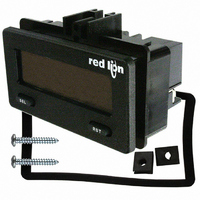CUB5B000 Red Lion Controls, CUB5B000 Datasheet - Page 9

CUB5B000
Manufacturer Part Number
CUB5B000
Description
COUNTER/RATE IND DUAL RD/GN BKLT
Manufacturer
Red Lion Controls
Series
CUB5r
Type
Counter/Rate Indicatorr
Datasheet
1.CUB5RLY0.pdf
(16 pages)
Specifications of CUB5B000
Count Rate
20kHz
Number Of Digits/alpha
8
Input Type
Voltage, Switch Closure, Transistor Switch
Voltage - Supply
9 V ~ 28 V
Display Type
LCD Backlit
No. Of Digits / Alpha
8
Digit Height
11.7mm
Counting Speed
20kHz
Operating Temperature Range
-35°C To +75°C
Signal Input Type
Current
Display Mode
LCD Selectable Transmissive
Character Size
0.46"
Accuracy
±0.01% %
Connection Type
Screw
Counter Type
Electronic
Cut Out, Panel
2.68×1.3 "
Dimensions
2.95"L×1.86"W×1.54"H
Display Digit Height
0.46 "
Frequency, Operating
20 kHz (Max.)
Function
Counter/Rate Indicator
Material, Casing
Plastic
Memory Type
E2PROM
Mounting Type
Panel
Number Of Digits
8
Primary Type
Electronic
Range, Measurement
-9999999 to 999999
Special Features
Programmable
Standards
CE Approved
Temperature, Operating, Range
0 to 60 °C
Terminal Type
Screw Terminal
Termination
Screw Terminal
Voltage, Supply
9 to 28 VDC
Weight
85 g
Memory
Nonvolatile EEPROM
User Input
Programmable, Connect to Common to Activate Function
Rate Minimum Input Frequency
0.01 Hz
Rate Maximum Frequency
20 kHz
Operating Temperature
0 to 60°C
Panel Cutout
2.68" × 1.30"
Backlight Power
9-28VDC
Backlighting Color
Red Or Green
Rohs Compliant
Yes
Lead Free Status / RoHS Status
Lead free / RoHS Compliant
Output Type
-
Lead Free Status / Rohs Status
RoHS Compliant part
Other names
RLC122
Available stocks
Company
Part Number
Manufacturer
Quantity
Price
Company:
Part Number:
CUB5B000
Manufacturer:
Red Lion Controls
Quantity:
135
SCALING FOR RATE INDICATION
Input value. These values are internally plotted to a display value of 0 and input
value of 0.0 Hz. A linear relationship is formed between these points to yield a
rate display value that corresponds to the incoming input signal rate. The meter
is capable of showing a rate display value for any linear process.
SCALING CALCULATION
those values can be entered into Scaling Display (
(
known, then it can be entered as the Scaling Input value and the Scaling Display
value will be entered as the following:
NOTES:
EXAMPLE:
updates for the rate display. Values of 0.1 and 0.2 seconds will update the
display correctly but may cause the display to appear unsteady.
display is forced to zero. (For more explanation, refer to Rate Value
Calculation.) The High Update Time must be higher than the Low Update Time
and higher than the desired slowest readable speed (one divided by pulses per
second). The factory setting of 2.0, will force the display to zero for speeds
below 0.5 Hz or a pulse every 2 seconds.
LO-Udt
HI-Udt
RAtE INP
To scale the rate, enter a Scaling Display value with a corresponding Scaling
If a display value versus input signal (in pulses per second) is known, then
If only the number of pulses per ‘single’ unit (i.e. # of pulses per foot) is
1. If # of pulse per unit is less than 10, then multiply both Input and Display
2. If # of pulse per unit is less than 1, then multiply both Input and Display
3. If the Display value is raised or lowered, then Input value must be raised
4. Both values must be greater than 0.0.
1. With 15.1 pulses per foot, show feet per minute in tenths. Scaling Display
2. With 0.25 pulses per gallon, show whole gallons per hour. (To have greater
The Low Update Time is the minimum amount of time between display
The High Update Time is the maximum amount of time before the rate
values by 10.
values by 100.
or lowered by the same proportion (i.e. Display value for per hour is
entered by a third less (1200) then Input value is a third less of # of pulses
per unit). The same is true if the Input value is raised or lowered, then
Display value must be raised or lowered by the same proportion.
= 60.0 Scaling Input = 15.1.
accuracy, multiply both Input and Display values by 10.) Scaling Display
= 36000 Scaling Input = 2.5.
RATE PER
). No further calculations are needed.
Second
Minute
Hour
01. 0
02. 0
RATE HIGH UPDATE TIME
RATE LOW UPDATE TIME
DISPLAY (
0. 1
0. 2
to
to
3600
60
1
RAtE dSP
99. 9
99. 9
seconds
seconds
)
RAtE dSP
# of pulses per unit
# of pulses per unit
# of pulses per unit
INPUT (
) and Scaling Input
RAtE INP
)
9
INPUT FREQUENCY CALCULATION
edges received during a sample period of time. The sample period begins on the
first falling edge. At this falling edge, the meter starts accumulating time
towards Low Update and High Update values. Also, the meter starts accumulating
the number of falling edges. When the time reaches the Low Update Time value,
the meter looks for one more falling edge to end the sample period. If a falling
edge occurs (before the High Update Time value is reached), the Rate display
will update to the new value and the next sample period will start on the same
edge. If the High Update Time value is reached (without receiving a falling edge
after reaching Low Update Time), then the sample period will end but the Rate
display will be forced to zero. The High Update Time value must be greater than
the Low Update Time value. Both values must be greater than 0.0. The input
frequency calculated during the sample period, is then shown as a Rate value
determined by the scaling calculation.
The meter determines the input frequency by summing the number of falling











